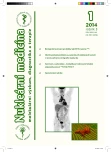Seminoma and sarcoidosis – complication of treatment response evaluation with 18F-FDG PET/CT – case report
Authors:
Jiří Vašina 1,2; Ondřej Bílek 3; Zdeněk Řehák 1; Radek Lakomý 3; Renata Koukalová 1
Authors‘ workplace:
Oddělení nukleární medicíny a PET, Masarykův onkologický ústav, Brno
1; Centrum molekulárního zobrazování, Mezinárodní centrum klinického výzkumu (ICRC) FN u sv. Anny, Brno
2; Klinika komplexní onkologické péče, Masarykův onkologický ústav, Brno
3
Published in:
NuklMed 2014;3:14-17
Category:
Casuistry
Overview
Introduction:
18F-FDG PET/CT is a part of initial diagnosis and follow-up of the treatment response in patients with seminoma. Spread of the seminoma except of regional paraaortal lymph nodes is most frequently into the lungs, mediastinal and supraclavicular lymph nodes; less frequently into other organs (liver, brain). Coincidence with sarcoidosis is usually mentioned as a complication of diagnosis and follow-up.
Case report:
We describe two patients with testicular tumor, typical seminoma, pT1, with normal level of tumor markers. Both had intensive accumulation of 18F-FDG in the mediastinal and hilar lymph nodes without involvement of retroperitoneum. Histological verification was not recommended in the first patient (42 y/o); he underwent oncological chemotherapy with partial effect after the first line but with progression after the second line. Mediastinoscopy with histology confirmed sarcoidosis. Initial histological verification from mediastinum was performed in the second patient (45 y/o); sarcoid granulomatosis was confirmed. Pathological foci in retroperitoneum, pelvis and spine were detected on follow-up 18F-FDG PET/CT. It was considered as a progression of sarcoidosis, progression of seminoma was less probable.
Conclusion:
It is necessary to take into account also other causes of the pathological pattern of tumor spread if it is not very typical. Sarcoidosis coincides quite frequently also with lung cancers or lymphomas. Histological verification is essential in such cases.
Key Words:
seminoma, sarcoidosis, fluorodeoxyglucose, PET/CT
Sources
1. Dušek L, Mužík J, Kubásek M. Epidemiologie zhoubných nádorů v ČR [online]. Masarykova univerzita, 2005. [cit. 2014-1-28]. Dostupné na www.svod.cz. Verze 7.0 [2007]
2. Schmoll HJ, Jordan K, Huddart R et al. Testicular seminoma: ESMO Clinical Practice Guidelines for diagnosis, treatment and follow-up. Ann Oncol 2010;21(S5):140-146
3. Ambrosini V, Zucchini G, Nicolini S et al. 18F-FDG PET/CT impact on testicular tumours clinical mamangement. Eur J Nucl Med Mol Imaging, 2013, DOI: 10.1007/s00259-013-2624-3
4. Askling J, Grunewald J, Eklund A et al. Increased risk for cancer following sarcoidosis. Am J Respir Crit Care Med 1999;160:1668-1672
5. Romer F, Hommelgaard P, Schou G. Sarcoidosis and cancer revisited: A long-term follow-up study of 555 Danish sarcoidosis patiens. Eur Respir J 1998;12:906-912
6. Rayson D, Burch PA, Richardson LR. Sarcoidosis and Testicular Carcinoma, Cancer 1998;83;337-343
7. Mostard RLM, Vöö S, van Kroonenburgh MJPG. Inflammatory aktivity assessment by F18 FDG-PET/CT in persistent symptomatic sarcoidosis. Resp Med 2011;105:1917-1924
8. Kaikani W, Boyle H, Chatte G. Sarcoid-like Granulomatosis and Testicular Germ Cell Tumor: The „Great Imitator“. Oncology 2011;81:319-324
Labels
Nuclear medicine Radiodiagnostics RadiotherapyArticle was published in
Nuclear Medicine

2014 Issue 1
Most read in this issue
- Seminoma and sarcoidosis – complication of treatment response evaluation with 18F-FDG PET/CT – case report
- Biological testing of antibody IgG M75 labelled by 125I
- Nursing problems in patients during stress tests as a part of myocardial perfusion scintigraphy
- What can you see on the image?
